Summary
Catalog Price Compatibility Social functions Music recommendations Audio quality Spatial audio File management and downloading Additional functions The best music streaming platform CommentsYou hesitate between Spotify, Deezer or Apple Music? Wondering what are the interests of Qobuz, YouTube Music or Tidal? We help you choose the best streaming service for your needs.
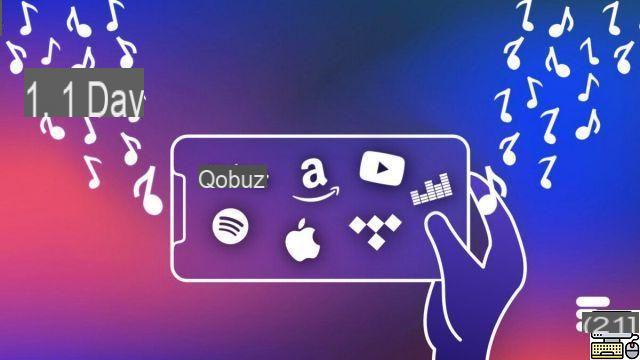
The best music streaming apps //
For nearly fifteen years, music has been streamed. While Spanish users have been familiar with Deezer and Spotify since 2007 and 2010, other services have since emerged, whether from Web giants such as Apple Music, YouTube Music or Amazon Music, or from resolutely oriented platforms. towards audiophiles like Tidal or Qobuz.
But among these many music streaming services, which one is the most interesting? What are the catalogs for each platform, the price of the subscription, the quality of the audio files offered, the presence of spatial audio files, the compatible devices or quite simply the price of each offer? This is what we will see together, in order to determine what is the best music streaming offer, but especially the one most suited to your needs.
The catalog of streaming platforms
The various music streaming services have understood this well: the catalog is the sinews of war. Logical, therefore, that everyone communicates on the number of millions of titles available with their subscription. And in this little game, the different services are playing the big muscles.
| Platform | Catalog size |
|---|---|
| Amazon Music | Over 75 million tracks |
| Apple Music | Over 75 million tracks |
| Deezer | 73 million tracks |
| Qobuz | Over 70 million tracks |
| Spotify | Over 70 million tracks |
| Tidal | Over 80 million tracks |
| YouTube Music | No number given |
On paper, all the main music streaming platforms therefore boast of having between 70 and more than 80 million titles in their catalog. If the Tidal announces “more than 80 million” of titles, against “more than 70 million” for Qobuz and Spotify this number is not necessarily representative.
It must be said that the quality of the catalog is not limited to the number of titles offered and the number of artists signed, but indeed to the presence - or absence - of the titles you want to listen to. To assess this more subjective criterion, we tried an exercise. Seven members of the editorial staff came up with a list of ten tracks. If the title was present - on the right album - on a platform, it was awarded a point. If it is absent, it is zero points. If it is present, but only on a compilation, a single or a best of, but not the requested album - or without an album in the case of YouTube Music - it is awarded half a point.
With this protocol, which is as representative as possible, we arrive at this result:
| Platform | Number of titles found | Percentage of relevance |
|---|---|---|
| Amazon Music | Zones | 92,86 % |
| Apple Music | Zones | 90,71 % |
| Deezer | Zones | 87,86 % |
| Qobuz | Zones | 80,71 % |
| Spotify | Zones | 92,86 % |
| Tidal | Zones | 87,14 % |
| YouTube Music | Zones | 93,57 % |
Detailed results, as of 15/12/2020, can be found here.
As we can see, all platforms achieve roughly similar results, close to 90% relevance. This is quite logical, since labels generally sign with all platforms, or even go through automated services to do it for them. This is why when a group like Ghinzu is absent from one or more platforms, there is a good chance that they will be absent from all of them.
YouTube Music clearly stands outQobuz, however, lags far behind its competitors, when Amazon Music and Spotify are tied for second place. The first, YouTube Music clearly stands out in that with the exception of one track, all the others are available in one way or another, even though they are not necessarily associated with their album.
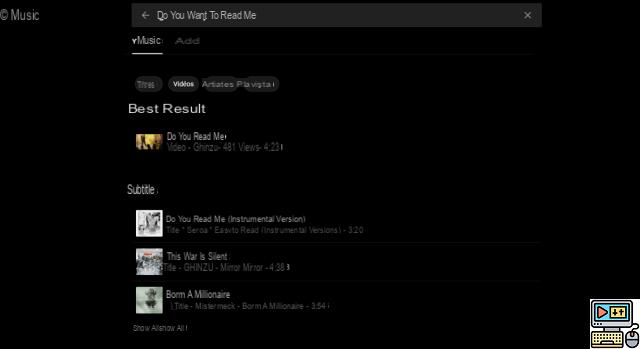
YouTube Music gives you access to videos for titles not in the catalog //
However, as we have seen, YouTube Music does not announce any catalog figures, and it is rather logical. Unlike Spotify, Deezer or Apple Music, YouTube Music relies on content already posted on its platform. We will therefore find titles from the official pages of artists signed by YouTube Music, but also songs captured by Internet users in concert or uploaded by themselves. Therefore, YouTube Music does not need to announce a number of titles in its catalog: virtually all the songs in the world can be found there, provided that they have been uploaded by Internet users.
On this point, the comparison is therefore final and YouTube Music is largely winning the round.
What is the price of music streaming platforms?
In terms of price, paid subscriptions can go from simple to double from one platform to another. It is also not always easy to know the advantages of everyone's premium subscriptions or to know what is the advantage of the paid model over the free model.
Trial offers and free offers
Once again, on this point, tables are therefore better than a thousand words:
| Platform | Trial offer and free offer |
|---|---|
| Amazon Music | 3 month trial, free offer with advertising limited to the best playlists |
| Apple Music | 3 month trial, no free offer |
| Deezer | 3 month trial, free plan with advertising, shuffle play, and no offline mode |
| Qobuz | 1 month trial, no free offer |
| Spotify | 3 month trial, free offer with ads and without offline mode |
| Tidal | 1 month trial, free offer with ads and without offline mode |
| YouTube Music | 4 month trial, free plan with ads, no offline mode, and no background playback |
The seven selected services therefore offer a trial offer, ranging from one to three months. Convenient to give a precise idea of the offer and the features offered on each platform before starting to pay any euro.
In addition to these time-limited trial offers, some services also offer free, unlimited offers. This is the case of Amazon, Deezer, Spotify, Tidal and YouTube Music, but neither of Apple Music, nor of Qobuz. In any case, these free offers are financed by advertising. They generally do not allow you to download titles offline and can be restricted in use, like that of YouTube Music, which does not allow you to listen to the songs in the background on your smartphone.
Amazon, Deezer, Spotify, Tidal and YouTube Music stand outOverall, on trial or free uses, these are mostly Amazon, Deezer, Spotify, Tidal and YouTube Music stand out from the crowd. The last, thanks to the four months of testing, the other two because they allow you to enjoy music on your smartphone, even running in the background.
Premium, HD, HiFi, Studio Premier offers ...
When you look at the paid offers of the different services, it can be dizzy. It must be said that some platforms are not satisfied with just one, but two, or even three subscription offers. In addition to the differences in terms of payment - monthly or annual, with or without commitment - these different offers may have implications on the features available or on the quality of the titles offered:
- Amazon Music: integrated with Amazon Prime (Music Prime) or 9,99 euros per month (Unlimited HD)
- Apple Music: 9,99 euros per month
- Deezer: 9,99 euros or 14,99 euros per month
- Qobuz: 19,99 euros per month or 249,99 euros per year
- Spotify: 9,99 euros per month
- Tidal: 9,99 euros or 19,99 euros per month
- YouTube Music: 9,99 euros per month
We have chosen here, for reasons of understanding, not to select than personal subscriptions with a monthly subscription, without a one-year commitment. Note, however, that Spotify, Apple Music or Deezer also offer family offers or for a couple, sometimes with additional functions such as family playlists or parental controls. It is often also possible to subscribe to a student offer at a lower price, generally at 4,99 euros per month. On the Spotify side, the Swedish streaming platform increased the price of its premium duo and family packages in April 2021. The first went from 11,99 to 12,99 euros per month and the second from 14,99 to 15,99 euros. The individual packages, at 9,99 euros per month, and student, at 4,99 euros per month, have not, however, increased.
However, with the exception of Qobuz, all platforms offer a first price of 9,99 euros per month, which can however go up to 14,99 or 19,99 euros per month in HD, HiFi, HiFi Plus or Studio offers. First.
At Amazon, three offers coexist: Amazon Music Free, Amazon Music Prime and Amazon Music HD.
| Amazon Music Prime | Amazon Music HD | |
|---|---|---|
| Price | Integrated with Amazon Prime subscription | 9,99 euros per month |
| Catalogue | more than 2 million tracks | more than 60 million tracks |
| Quality | SD | HD |
The differences thus play out on the size of the catalog to switch from the Amazon Music Prime offer, included in the Amazon Prime subscription, to the Amazon Music HD subscription. The previously available Amazon Music Unlimited package is gradually being replaced by Amazon Music HD, since it is offered at the same price of 9,99 euros per month. The HD offer also allows you to enjoy titles in high definition. In May 2021, Amazon also reshuffled the cards. The service announced the arrival of Amazon Music HD at 9,99 euros per month for all subscribers, old and new.
As for Qobuz, this time two offers coexist: Qobuz Studio Premier and Qobuz Studio Sublime:
| Qobuz Studio Premier | Qobuz Studio Sublime | |
|---|---|---|
| Price | 14,99 euros per month or 149,99 euros per year | 199,99 euros per year |
| Catalogue | Over 70 million tracks | Over 70 million tracks |
| Quality | Studio quality (24-bit FLAC up to 192 kHz) | Studio quality (24-bit FLAC up to 192 kHz) |
| Reduced prices for purchases | No | Yes |
Here the catalog and the quality are both identical. Logical, since the sound quality is the main point put forward by Qobuz compared to the competition. The distinction between the two offers therefore depends on the preferential rates offered thanks to the “sublime” subscription when purchasing music in Hi-Res.
At Tidal, this time we will find two separate paid offers, Tidal HiFi and Tidal HiFi Plus:
| Tidal hifi | Tidal HiFi Plus | |
|---|---|---|
| Price | 9,99 euros per month | 19,99 euros per month |
| Catalogue | Over 80 million tracks | Over 80 million tracks |
| Quality | 16-bit quality at 44,1 kHz | 24-bit quality at 192 kHz |
The distinction between the two offers is made in particular on the sound quality offered, with CD quality sound at 10 euros per month and Masters sound for the 20 euros version. In addition, the 20 euros offer allows you to take advantage of spatial audio as well as a more advantageous remuneration for artists.
Finally, Deezer also offers two paid offers - not counting the family plan - Deezer Premium and Deezer HiFi:
| Deezer Premium | Deezer Hi-Fi | |
|---|---|---|
| Price | 9,99 euros per month or 99,90 euros per year | 14,99 euros per month |
| Catalogue | 56 million tracks | 56 million tracks |
| Quality | MP3 320 kbps, compressed, high quality | 16-bit FLAC, 1411 kbps, lossless, CD quality |
Here too, it is therefore the quality of the songs that will make it possible to choose between one subscription and the other. Regarding the detail of this audio quality, we will come back to it later, in the dedicated part.
Apple is not left out, and if there is no need for a table to explain the different offers, it is because the Apple Music service offers a single subscription, at 9,99 euros per month, also offering the titles in HD quality.
Overall, to enjoy a streaming service without paying attention to the sound quality, all are the same. For the lossless versions of the songs, Apple, Amazon and Tidal have the advantage of offering a HiFi or HD version from 9,99 euros per month, compared to 14,99 euros per month for Deezer and Qobuz.
Note also that Spotify does not intend to be outstripped in the field of Hi-Fi audio. The Swedish streaming service indeed announced in February 2021 its desire to launch a music service in "CD quality". We can therefore expect files encoded in 16 bits at 44,1 kHz, as on Deezer. This formula should be offered at a higher price, but Spotify has not yet disclosed its prices.
Platforms, connected speakers and number of connected devices
It's good, you have subscribed to the offer that seemed the most interesting to you on paper, so now is the time to install your streaming software to use it on your Android smartphone or your iPhone. No problem. And then why not take the opportunity to listen to music on your Amazon Echo or Google Home speaker. Ah, it's starting to block. And if you also plan to enjoy your music on the PlayStation 5, it is immediately more limiting.
Not all streaming platforms are compatible with all media. If we can sometimes get away with third-party applications or hack, the easiest way is nevertheless to take advantage of the application offered by the streaming service itself. And in this little game, not everyone is in the same boat:

The compatibility of services with different platforms // source: TechnologiesTips
On this criterion, Deezer, Spotify and Apple Music win the round. The former is compatible with almost all platforms, including Apple's HomePod speakers, with the exception of the PlayStation. With the Swedish service, we are offered on the Sony platform, but the only missing compatibility is that of Apple HomeKit, since Spotify cannot yet be used on HomePod speakers. Nevertheless, the American manufacturer has announced in recent months an opening of HomePods and, after Pandora across the Atlantic and Deezer, we would not be surprised to see Spotify land on Apple speakers. Finally, Apple Music has been available on Sony PlayStation consoles since October 2021, just like Spotify.
To learn more
HomePod will soon support Spotify, Deezer and others
The only points common to all the platforms are the iOS, web and Android versions, since all of them offer a website or an application to listen to your music. On the side of YouTube Music, on the other hand, we come largely to the last position on this criterion. It must be said that Google's service does not even offer applications for PC or Mac, favoring the Web version.
Social functions and collaborative playlists
Listening to music is good. Sharing it with friends is better. In addition to the couple or family offers offered by some, several platforms also offer social features. While some platforms offer compatibility with Last.fm, others go further.
Activity sharing
On Spotify, for example, you can link your account to Facebook to see what our friends are listening to and possibly listen to the same songs as them at the same time. This function also allows you to discover playlists of your friends, or see the albums they are listening to. Deezer offers a function that is similar with a social network aspect that will allow you to discover the albums, artists or playlists the most listened to by its followers. The function is however a little more buried, since it asks to go to the “favorites” menu of the service, then to go see the followers, where a side panel is available directly on Spotify.

Spotify lets you see what your friends are listening to
Apple Music also allows you to take advantage of social functions, but these are limited to the mobile versions, on iOS, iPadOS or Android. This feature will find out who in your contacts uses Apple Music and whether people can follow you automatically, or only after your approval.
For their part, Amazon Music, YouTube Music, Tidal and Qobuz do not offer any social function of this type.
Third party applications
Note that these social functions are only of interest if your loved ones use the same music streaming application. If this is not the case, you may well allow this function, it will be of little use. It is therefore the premium to Spotify, Deezer or Apple Music, without a lesser measure and this explains why the other four have not launched equivalent services.
Many services use Spotify APIsThe same goes for third-party services that may use your listening data to provide certain functions. The more popular music apps, the more interest third-party developers have in providing such services. This is the reason why many services use Spotify APIs to take stock of your musical tastes, to create collaborative playlist systems or to take quizzes depending on the popularity of a particular artist in the world. In this game, it is largely the Swedish platform that is doing the best and if you want to try all these apps, then better subscribe to Spotify.
Collaborative playlists
Finally, the last social aspect, particularly interesting in particular for organizing an evening, is the collaborative playlist. An increasingly popular function that allows you to create multiple playlists so as not to have to juggle between several titles. And, as usual, in this game the platforms are not all in the same boat:
| Collaborative playlists | |
|---|---|
| Amazon Music | No |
| Apple Music | No |
| Deezer | Yes |
| Qobuz | Yes |
| Spotify | Yes |
| Tidal | No |
| YouTube Music | Yes |
We therefore have four platforms that allow you to create collaborative playlists: Deezer, Qobuz, Spotify and YouTube Music. Note, however, that all the others allow you to share the playlist via a link or a share on Twitter or Facebook.
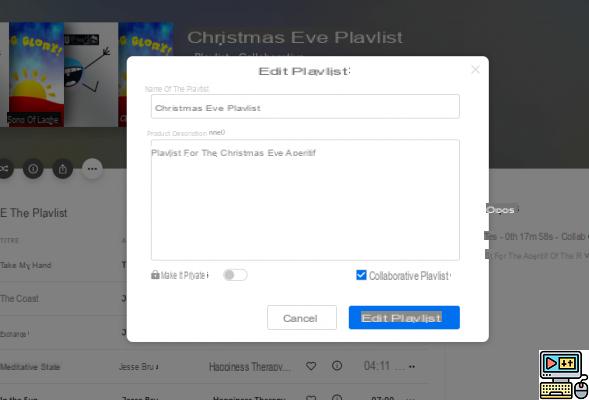
Qobuz allows you to create collaborative playlists
On social functions, it is therefore largely Spotify that wins the round, whether for activity sharing, third-party applications or collaborative playlists.
Automatic or editorialized recommendations and playlists
When it comes to playlists, it's not just collaboration or the ones you can create manually that matters. It's good to listen to music, but one of the interests of streaming platforms, not to listen to the same artists over and over, comes from the recommendations.
Algorithmic recommendations
In this area, it is the algorithms of the different platforms that will come into play online. Depending on the titles you have listened to in the past, they will recommend playlists or albums that are supposed to match your musical tastes. Some even go further by offering playlists based on the time of day, your activity or where you are.
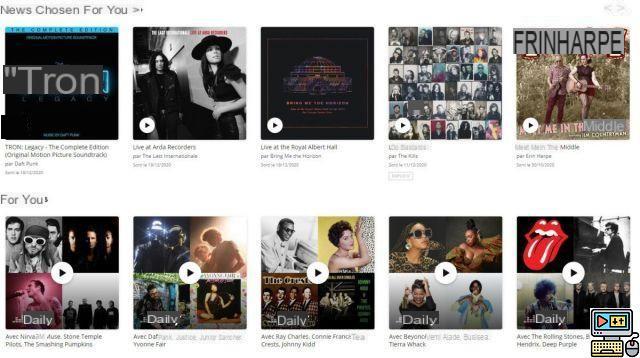
Deezer suggests titles and playlists to suit your tastes
These recommendations are generally offered from the service's home page with selections of new titles, albums, mixes or playlists. Note, however, that Qobuz is the only platform to only offer editorialized playlists, and not based on user listening. Even Apple Music, which does not offer algorithmic playlists on its home, will at least display albums that will interest you to listen more to this or that artist.
Editorialized playlists
Apple Music, Spotify, Deezer, Amazon Music, Tidal, YouTube Music, and Qobuz all also feature editorialized playlists, created by real people. These could be the choices of the service's editorial team - as in the case of Qobuz, Apple Music, Amazon Music or Spotify - or celebrities like Barack Obama and Nick Minaj (Tidal) or U2 or Brian Eno (Deezer).
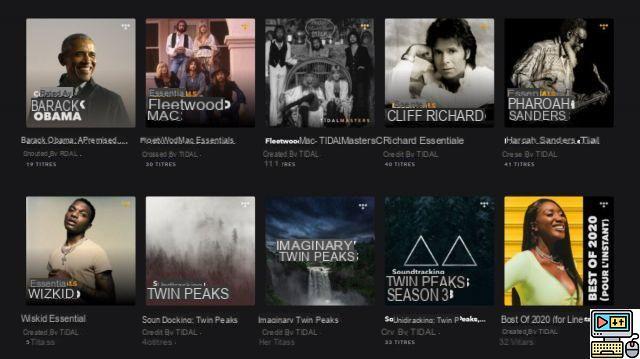
Tidal offers many editorialized playlists //
In the game of suggestions and playlists, most platforms therefore play on equal terms, even if Tidal and Deezer have the advantage of also offering certain playlists developed by artists or recognized personalities.
The sound quality of the songs
As we have seen, the audio quality offered by each platform is one of the main criteria put forward by the services, in particular to justify the premium offers or the higher prices of some.
It must be said that not all services use the same file formats, the same encoding or the same bandwidth. Some, like Spotify, even allow the audio quality to be changed on smartphones if users want to consume more or less data.
As mentioned earlier, Apple Music, Amazon Music HD, Tidal, and Deezer offer deals with higher quality files as well. For its part, Qobuz offers, even with the basic subscription at 14,99 euros per month, files up to 24-bit FLAC at 192 kHz. For other platforms, it is therefore advisable to modify the listening parameters to enjoy the best possible audio quality, whether it is “very high” on Spotify or “always high” on YouTube Music for example.
| Basic maximum quality | Maximum quality for a fee | |
|---|---|---|
| Amazon Music | FLAC 24 bits 192 kHz | |
| Apple Music | ALAC 24 bits 192 kHz | - |
| Deezer | MP3, 320 kbps | FLAC 16 bits 44,1 kHz |
| Qobuz | FLAC 24 bits 192 kHz | - |
| Spotify | Ogg Vorbis, 320 kbps | - |
| Tidal | FLAC 16 bits 44,1 kHz | FLAC 24 bits 192 kHz |
| YouTube Music | AAC, 256 kbps | - |
If Qobuz has long done the best in terms of audio quality for its basic package, which is higher than its competitors, it is now being attacked head-on by Amazon, Apple and Tidal. The three American giants now offer a basic package at 9,99 euros per month, at no additional cost, up to 16-bit 44,1 kHz or 24-bit 192 kHz quality.
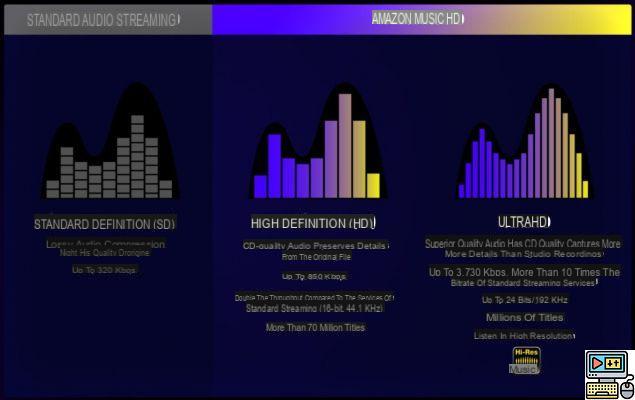
The different qualities offered on Amazon Music
In terms of maximum quality, all prices combined, four players are tied: Amazon Music HD, Apple Music, Qobuz and Tidal HiFi Plus. The three services indeed offer titles up to FLAC - or ALAC at Apple - encoded in 24 bits at 192 kHz. For its part, Deezer, which has a similar offer, is limited to FLAC in CD quality, ie 16 bits at 44,1 kHz. Spotify is going to launch a CD-quality subscription, like Deezer, but the offer is not yet available.
Not all songs are available at the maximum quality.Note, however, that not all songs are available with maximum quality. Even on Qobuz, not all titles are available in 24-bit 192kHz and platforms usually indicate what the quality of each title is. The playback of these files in very high definition will also depend on your device, not all computers and smartphones being able to decode such files. At Apple Music for example, 24-bit 192 kHz quality is only offered if you have a DAC. Without this, the maximum quality offered is 24 bits at 48 kHz.

Tidal specifies when the album is available in master version
Finally, it is worth emphasizing one point: the quality of listening depends above all on the original file. Not all Flac titles are created equal and, in principle, you could very well end up with a 16-bit 44,1 kHz title that has been re-encoded by a 24-bit 192 kHz platform. This does not necessarily mean that the quality will be better, since if the information was not there originally, there is no chance that it was added during re-encoding.
This point is all the more valid for YouTube Music. The service offers files up to AAC at 256 kbps, inherited from Google Play Music, but also videos uploaded by Internet users. And on this point, the quality will depend only on the file that was initially offered on the video platform. Note however that, when the title is available in the catalog of the platform, YouTube Music will always favor the official version to a video uploaded by Internet users.
Spatial audio
In addition to CD quality, or even hi-res files, more and more music streaming services are offering a form of spatial audio listening. Essentially, these are files encoded in Dolby Atmos or Sony 360 Reality Audio, in order to offer greater immersion in one's music.
Concretely, these titles will make it possible to benefit from a surround effect even more important than the original mix. In most cases, these files are compatible with all headsets and headphones. They can also take on their full meaning on a more complete musical installation, such as a home cinema system in Dolby Atmos. Note, however, that Sony files are only available on PCs or smartphones, but not with an amplifier or home cinema.
As we have seen, it is Dolby and Sony which provide all the spatial audio files on the market. The streaming services are therefore supplied from one of these providers, from both, or from neither if the function is not supported:
| Dolby Atmos for Music | Sony 360 Reality Audio | Price to enjoy it | Application required | |
|---|---|---|---|---|
| Amazon Music | Yes | Yes | 9,99 euros per month | Basic app |
| Apple Music | Yes | No | 9,99 euros per month | Basic app |
| Deezer | No | Yes | 14,99 euros per month | Specific app |
| Qobuz | No | No | - | - |
| Spotify | No | No | - | - |
| Tidal | Yes | Yes | 19,99 euros per month | Basic app |
| YouTube Music | No | No | - | - |
Of the seven main music streaming services, four therefore offer spatial audio: Amazon Music, Apple Music, Deezer and Tidal. Also, Amazon Music and Tidal are compatible with both Sony's solution and Dolby's solution, while Apple Music only supports Dolby Atmos and Deezer, Sony 360 Reality Audio. On the side of Qobuz, Spotify and YouTube Music, spatial audio is still pending.
In addition, three points should be noted with regard to compatible services. On the one hand, Deezer has chosen to push another application so that its subscribers can use spatial audio: 360 by Deezer. The files are indeed not compatible with the classic Deezer application. On the other hand, Amazon and Apple have chosen to offer spatial audio at no extra cost - such as CD quality files - while Tidal and Deezer require a specific subscription.
Finally, we should salute the initiative of Apple Music, which goes so far as to offer spatial audio with tracking of the movements of the head. As long as you are using an Apple device and headphones - for example an iPhone 13 and AirPods 3 - you may feel like you have the recording in front of you and hear it move if you turn your head. All the files are not equal and some, more worked, will only move the singer's voice while the instruments will not move even if you turn your head. This function is however restricted to only users immersed in the Apple ecosystem. Note, however, that classic spatial audio remains available for users of Android smartphones or owners of headsets or headphones not stamped with the apple logo.
Offline download, add files, and offline download
If the catalog of a streaming service turns out to be small, it may still be interesting to use the application to listen to your own songs. Two paths then open up:
- Adding titles to the catalog: to enjoy them from all devices
- Local track playback: to use the streaming application to listen to tracks stored on the same device
Adding files locally or in the cloud
The first option is still rather rare. However, it is mainly thanks to this that Google Play Music was able to stand out from the competition. The service made it possible to put all his songs online so that they could be found freely on his smartphone or another computer.
| Adding titles to the catalog | Playing local titles | |
|---|---|---|
| Amazon Music | Yes | Yes |
| Apple Music | Yes | Yes |
| Deezer | Yes | Yes |
| Qobuz | No | Yes |
| Spotify | No | Yes |
| Tidal | No | No |
| YouTube Music | Yes | Yes |
Five platforms now offer to upload their own files to find them anywhere: Spotify, Amazon Music, Apple Music, Deezer and YouTube Music. However, the task is not always easy, far from it. For Apple Music, you will need to be subscribed to an iCloud account. For Amazon Music, it is a separate utility, to be installed on your PC, which will allow you to upload your tracks. For Deezer, the option is well hidden, in favorites then in "my MP3". Finally, Spotify encourages you to create a specific playlist on your computer that you can download later on your smartphone, while being connected to the same Wi-Fi network.
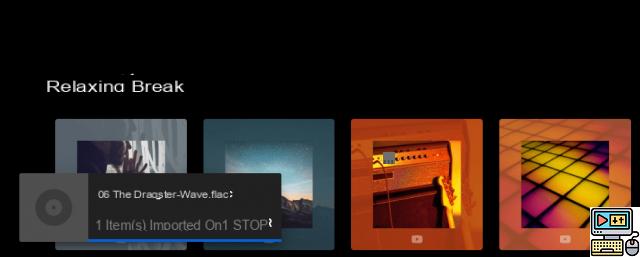
YouTube Music makes it very easy to add titles to the service
YouTube Music is a very good student, since it is possible to drag and drop the songs on the Web version of the site, to find them directly on the mobile application, with ease.
Offline download
On a smartphone, it can be practical, when you arrive in an area without network coverage and plan to fly, to download the songs locally on your device.
No problem there, since all seven music streaming services allow offline songs to be downloaded for offline listening.
Lyrics, music videos, podcasts, etc.
In addition to all the features that can be considered essential to a good music listening experience, the different platforms are full of additional functions to enrich the experience with more content than just musical titles.
| Clips | Booklets | Lyrics | Podcasts | Radio | |
|---|---|---|---|---|---|
| Amazon Music | No | No | Yes | No | No |
| Apple Music | Yes | No | Yes | No | Yes |
| Deezer | No | No | Yes | Yes | Yes |
| Qobuz | No | Yes | No | No | No |
| Spotify | No | No | Yes | Yes | No |
| Tidal | Yes | No | No | No | No |
| YouTube Music | Yes | No | Yes | No | No |
On this side, everyone therefore plays their own cards. The most common function is clearly the display of lyrics, since only Qobuz and Tidal do not offer it. This is also the only function offered by Amazon Music. As for the clips, they are available on Apple Music and Tidal, as well as, inevitably, on YouTube Music thanks to the artist channels..
Deezer is also the service offering the most additional features. since apart from displaying lyrics, the Spanish platform also offers podcasts – just like Spotify – as well as access to Spanish radio stations. For radios, Apple relies on its own in-house stations. Finally, Regarding podcasts, Spotify has gone all out for a few years, offering a number of original productions, available only from the Swedish platform.
What is the best music platform?
Once all of these criteria are factored in, it's time to take stock of each platform to determine which is the best music streaming service.
Qobuz: for wealthy audiophiles
Qobuz is clearly playing the audiophile card. And for that, the Spanish streaming service is playing cards on the table with a first offer available without commitment at 19,99 euros per month – or for 14,99 euros per month for a one-year commitment. Qobuz has the advantage of offering titles up to 24-bit quality at 192 kHz. However, the catalog is smaller than the competition. Limits also exist with regard to social functions and recommendations, necessarily editorialized and therefore not personalized according to your reading history. The offer is interesting for hi-fi enthusiasts, but the competition is often much more aggressive.
- Catalog: more than 70 million titles
- Price: 19,99 euros per month or 249,99 euros per year
- Quality: 24-bit FLAC up to 192 kHz
- Audio spatial: not
- Number of compatible platforms: 5

Qobuz
Download Qobuz free APK Subscribe to QobuzTidal: a lack of social functions
Tidal offers a top-of-the-range offer with attractive features, especially with the integration of music videos. The service nevertheless fails by the absence of collaborative playlists or any social functions. The number of compatible platforms is also quite limited since Tidal is not available on Google Home or HomePod. The price of the HiFi Plus version, at 19,99 euros, is also rather high compared to the competition to take advantage of spatial audio.
- Catalog: more than 80 million titles
- Price: 9,99 euros (HiFi) or 19,99 euros (HiFi Plus) per month
- Quality: 16-bit FLAC up to 44,1 kHz (HiFi) or 24-bit FLAC up to 192 kHz (HiFi Plus)
- Audio spatial : Dolby Atmos et Sony 360 Reality Audio (HiFi Plus)
- Number of compatible platforms: 6

Tidal
Download Tidal Free APK Subscribe to TidalDeezer: correct service
Deezer is a historical player in the online music industry. Logic, therefore, that it offers many integrations and that it is one of the few to work on HomePod. The only thing missing is the PlayStation Store. The service also offers a version with lossless quality at 14,99 euros per month, a higher price than Amazon and Apple Music. This is also CD quality and not HD. Note also that the Deezer catalog is advertised as a little smaller than the competition. This is a good offer, but other services offer even better.
- Catalog: 73 million titles
- Price: 9,99 euros (Premium) or 14,99 euros (HiFi) per month
- Quality: 3 kbps MP320 (Premium) or 16-bit FLAC up to 44,1 kHz (HiFi)
- Audio spatial : Sony 360 Reality Audio (HiFi)
- Number of compatible platforms: 9
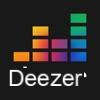
Deezer
Download Deezer Free APK Subscribe to TidalApple Music: a good catalog and many functions
Apple is a fairly recent player in online music. Nevertheless, the manufacturer has lapped for a long time with the iTunes Store and benefits from a large catalog. In just a few years, Apple Music has established itself as a major service to compete with the main platforms in the sector, in particular thanks to its compatibility with a large number of devices. The unique offer at 10 euros per month is also very easy to understand and very complete with titles in lossless quality. Finally, Apple can boast of having a very large catalog of 70 million titles, exclusive radio stations, video clips and the integration of lyrics.
- Catalog: more than 75 million titles
- Price: 9,99 euros per month
- Quality: 16 or 24 bit ALAC, 44,1, 48 or 192 kHz
- Spatial audio: Dolby Atmos (with head tracking for Apple products)
- Number of compatible platforms: 9

Apple Music
Download Apple Music Free APK Subscribe to Apple MusicAmazon Music: The Best Deal for Audiophiles
Amazon's music offering is not easy to understand at first, and for good reason: it is made up of three distinct offers, Free, Prime and HD. We will focus on the last one, the only one to offer access to the full catalog of 70 million titles on the platform. And on this point, we must recognize that Amazon Music HD has something to seduce with a very affordable price and high definition audio quality. Often forgotten, it is however the pleasant surprise of this comparison, in particular for audiophiles. Too bad the service is not supported by Google Home or HomePod speakers and social functions are rather limited.
- Catalog: more than 75 million titles
- Price: 9,99 euros per month
- Quality: 24-bit 192 kHz FLAC
- Audio spatial : Dolby Atmos et Sony 360 Reality Audio
- Number of compatible platforms: 7

Amazon Music
Download Amazon Music Free APK Subscribe to Amazon MusicSpotify: the best service to reach your friends
On paper, Spotify offers a fairly classic formula with a single price of 9,99 euros per month, a catalog in the average competition with 70 million titles and a quality limited to 320 kbps. However, its strength actually lies in its number of users. Thanks to this, the platform offers a lot of social functions, a lot of music recommendations, a large number of compatible devices - all of them except, for now, the HomePod - and even third-party applications designed by developers based on it. APIs of the service. Perhaps the greatest strength of Spotify is that your friends are already on it.
- Catalog: more than 70 million titles
- Price: 9,99 euros per month
- Quality: Ogg Vorbis up to 320 kbps
- Audio spatial: not
- Number of compatible platforms: 9

Spotify
Download Spotify Free APK Subscribe to SpotifyYouTube Music: the most complete catalog
Born from the ashes of Google Play Music, YouTube Music is arguably the most comprehensive music streaming service out there today. If the audio quality is capped, in the best case, at AAC at 256 kbps, Google's service stands out from the competition by its catalog. It must be said that it is not limited to artists who have signed with YouTube Music, but also includes all the videos uploaded to the video service. YouTube Music also has the advantage of allowing you to add your own songs to the catalog with a simple drag and drop. Finally, the only shortcoming of the platform is its very limited compatibility with devices, apart from the website and the iOS and Android applications.
- Catalog: Not communicated
- Price: 9,99 euros per month
- Quality: AAC 256 kbps
- Audio spatial: not
- Number of compatible platforms: 4

YouTube Music
Download YouTube Music Free APK Subscribe to YouTube Music


























